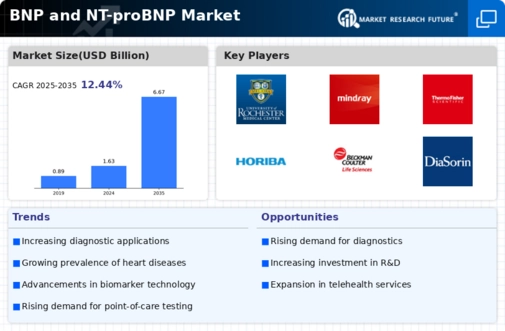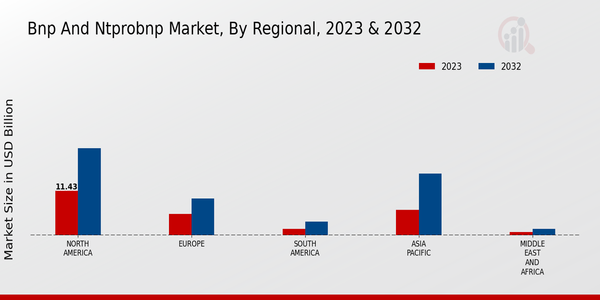Market Growth Projections
The Global BNP and NT-proBNP Market Industry is projected to experience substantial growth over the coming years. In 2024, the market is expected to be valued at 1.63 USD Billion, with forecasts indicating a rise to 6.67 USD Billion by 2035. This growth trajectory suggests a compound annual growth rate of 13.66% from 2025 to 2035. Such projections reflect the increasing demand for effective heart failure diagnostics and the ongoing advancements in testing technologies. The market's expansion is likely to be driven by a combination of factors, including rising prevalence of cardiovascular diseases, technological innovations, and supportive regulatory environments.
Rising Prevalence of Heart Failure
The increasing incidence of heart failure globally is a primary driver of the Global BNP and NT-proBNP Market Industry. As populations age, the prevalence of cardiovascular diseases escalates, leading to a higher demand for diagnostic tools like BNP and NT-proBNP tests. In 2024, the market is projected to reach 1.63 USD Billion, reflecting the urgent need for effective heart failure management. This trend is expected to continue, with the market potentially expanding to 6.67 USD Billion by 2035, indicating a compound annual growth rate of 13.66% from 2025 to 2035. Such growth underscores the critical role of these biomarkers in clinical practice.
Market Dynamics and Competitive Landscape
The competitive landscape of the Global BNP and NT-proBNP Market Industry is characterized by a diverse range of players, including established companies and emerging startups. This dynamic environment fosters innovation and drives the development of new diagnostic products. Companies are increasingly investing in research and development to enhance the efficacy and reliability of BNP and NT-proBNP tests. Additionally, strategic partnerships and collaborations among industry stakeholders are likely to accelerate market growth. As the competition intensifies, the focus on improving patient outcomes and expanding market reach will shape the future of this industry.
Growing Awareness and Screening Initiatives
There is a notable increase in awareness regarding heart health and the importance of early detection of heart failure, which drives the Global BNP and NT-proBNP Market Industry. Public health campaigns and screening initiatives are being implemented worldwide to educate populations about cardiovascular risks. This heightened awareness encourages individuals to seek testing, thereby increasing the demand for BNP and NT-proBNP assays. As healthcare providers emphasize preventive care, the market is likely to experience robust growth, contributing to the projected rise from 1.63 USD Billion in 2024 to 6.67 USD Billion by 2035.
Regulatory Support and Reimbursement Policies
Supportive regulatory frameworks and favorable reimbursement policies are crucial for the expansion of the Global BNP and NT-proBNP Market Industry. Governments and health authorities are increasingly recognizing the value of BNP and NT-proBNP testing in managing heart failure, leading to improved reimbursement rates for these diagnostic tests. This financial backing encourages healthcare providers to adopt these assays more widely, thereby enhancing patient access to essential diagnostic tools. As reimbursement policies evolve to support innovative testing solutions, the market is expected to grow significantly, aligning with the projected CAGR of 13.66% from 2025 to 2035.
Technological Advancements in Diagnostic Tools
Technological innovations in diagnostic methodologies are significantly influencing the Global BNP and NT-proBNP Market Industry. Enhanced testing techniques, such as point-of-care testing and high-sensitivity assays, improve the accuracy and speed of heart failure diagnosis. These advancements not only facilitate timely treatment but also expand the accessibility of BNP and NT-proBNP testing in various healthcare settings. As healthcare systems increasingly adopt these technologies, the market is poised for substantial growth. The integration of digital health solutions further supports this trend, potentially leading to a more efficient healthcare delivery model and improved patient outcomes.












